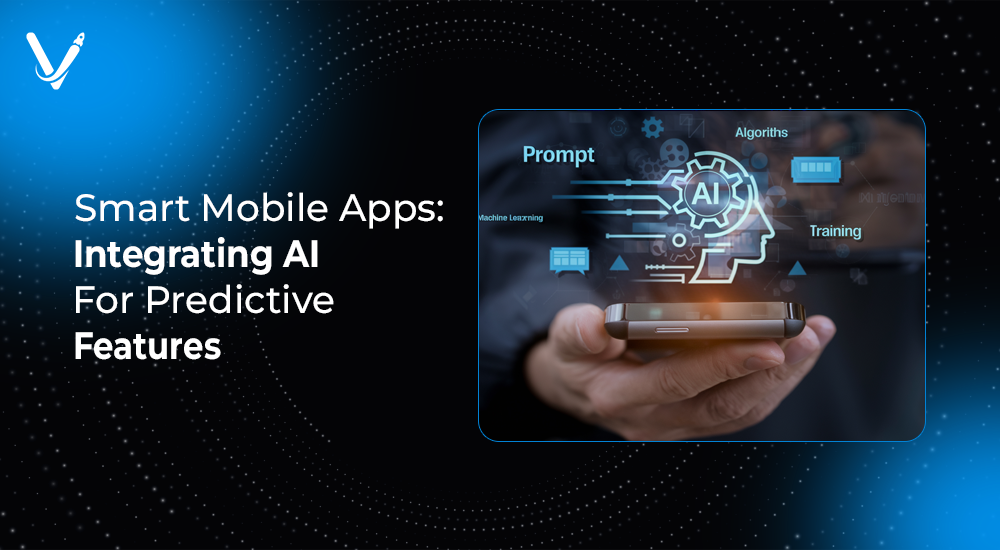Smart Mobile Apps: Integrating AI for Predictive Features


- Jun 2, 2025



Mobile apps have transformed modern life—helping us shop, exercise, learn, and manage finances. But as user expectations evolve, so must the apps themselves. Static functionality is no longer enough. Today’s users demand experiences that are tailored, intelligent, and anticipatory.
Enter predictive features powered by Artificial Intelligence (AI). Smart mobile apps that anticipate user behavior, recommend relevant content, automate actions, and prevent errors are leading the way. In this article, we’ll explore how integrating AI and predictive analytics into mobile apps drives personalization, retention, and user satisfaction—and how your business can harness these capabilities to stay competitive.
What sets a smart app apart from a basic one? It’s the ability to learn, adapt, and make intelligent decisions based on user data and behavior. Smart apps go beyond predefined responses. They evolve with usage, making every interaction more valuable.
Whether it’s suggesting the next song, predicting expenses, or recommending workouts, smart mobile apps reduce effort and increase value with every use.
AI is not a luxury—it’s a necessity in today’s app landscape. The competition for user attention is fierce. Users expect apps to work quickly, accurately, and personally. Businesses providing mobile app development services need a way to exceed expectations consistently, and AI delivers exactly that.
Leading companies are using AI to transform their apps into predictive platforms—and users are rewarding them with loyalty and engagement.
Predictive features are the core of smart mobile apps. These features transform reactive interactions into proactive, personalized experiences. Let’s look at the most common and impactful predictive functionalities found in today’s top apps.
Apps like Netflix, Amazon, and Spotify analyze user data—watch history, purchases, listening habits—to suggest tailored content. These recommendation systems use collaborative filtering and deep learning to improve with every interaction.
Impact:
Messaging and email apps like Gmail or WhatsApp offer auto-complete suggestions or one-tap replies based on recent context. These features speed up communication and reduce cognitive load.
Impact:
Fitness, wellness, and finance apps use behavioral data to forecast actions. For instance, MyFitnessPal predicts meal logging needs, while fintech apps alert users before overspending.
Impact:
Some apps alter their interface based on user behavior. If you frequently use a certain feature, the app may place it prominently or reduce clutter elsewhere.
Impact:
Security-focused apps monitor patterns and flag unusual activities—like login attempts from new locations or unexpected transfers. AI spots these anomalies in real time.
Impact:
To understand how mobile apps become intelligent, it's important to look behind the scenes. Predictive analytics involves a pipeline of data collection, model training, and real-time inference. In this section, we break down the process and explain how predictions are turned into action within an app.
Apps gather data from multiple touchpoints:
Raw data is cleaned, normalized, and transformed into structured inputs that feed machine learning algorithms. This includes encoding preferences, trends, and usage history.
AI models are trained to recognize patterns and make forecasts. Depending on the app’s goals, common models include:
Based on predictions, the app takes automated actions:
These outputs are continuously refined as new data comes in.
Seeing theory applied in successful apps makes the concept tangible. This section walks through popular mobile apps like Spotify, Uber, and Starbucks, showing how predictive AI enhances their functionality, boosts engagement, and drives revenue growth.
Spotify’s Discover Weekly and Daily Mix playlists use deep learning and collaborative filtering to predict what users will enjoy based on listening habits, skip rates, and playlists.
Uber predicts ride demand using location trends, historical data, and weather. It adjusts prices in real-time with dynamic pricing models and guides drivers to optimal pickup points.
Starbucks uses its Deep Brew AI engine to offer personalized suggestions, loyalty incentives, and order predictions based on time of day, order history, and local trends.
The meditation app personalizes session suggestions based on user goals, moods, and stress levels. AI models track progress and recommend ideal times for practice reminders.
AI integration isn’t magic—it’s the result of powerful frameworks, cloud platforms, and real-time processing tools. This section outlines the technologies developers use to build predictive features and deploy machine learning models effectively within mobile environments.
These technologies allow developers to design intelligent features without reinventing the wheel.
Adding predictive features to your app doesn’t happen overnight. It requires a structured approach that starts with the user, followed by data readiness and model integration. This section provides a practical roadmap for teams building or upgrading apps with predictive AI.
Define the user problem you want to solve. Is it better recommendations? Fraud alerts? Personalized flows?
Set up analytics tools to collect behavioral, contextual, and transactional data—ethically and transparently.
Choose the right model based on the problem. Train with historical data. Validate results rigorously before deployment.
Use an on-device or cloud-based inference engine to deliver real-time predictions. Test across devices and conditions.
Track prediction accuracy and business impact. Use feedback loops to improve your models over time.
Why should you invest in AI for your app? The benefits go beyond novelty—AI increases retention, improves personalization, and even opens new monetization opportunities. This section dives into the tangible advantages businesses gain when they embrace smart app features.
When your app delivers value before users even ask, you create trust—and that drives growth.
While the potential of predictive AI in mobile apps is enormous, developers must navigate challenges around performance, privacy, and fairness. This section examines the common hurdles teams face and how they can build responsibly while staying ahead of the curve.
Users must know what data is collected and why. Compliance with laws like GDPR and CCPA is critical.
If your training data is skewed, your predictions will be too. Regular audits and diverse datasets are essential.
AI models can consume processing power. Use lightweight models or offload predictions to the cloud.
Models need retraining as behavior and environments evolve. Don’t treat AI as “set and forget.”
AI in mobile apps is still in its early stages. As technology evolves, the line between human intuition and machine prediction will blur even further. This section takes a look at emerging trends and where predictive features are headed next in mobile app design.
As AI becomes more efficient and accessible, predictive mobile apps will become the norm—not the exception.
Smart mobile apps driven by AI and predictive features are setting a new standard for digital experiences. They don’t just respond—they anticipate. They don’t just guide—they learn.
For businesses, the question is no longer “Should we integrate AI?” but rather “How fast can we adapt?”
At Vasundhara Infotech, we specialize in building intelligent, AI-powered mobile applications that deliver real business outcomes. Whether you're a startup with a vision or an enterprise looking to scale, we help bring your predictive app ideas to life.
Let’s turn your mobile app into a smart, predictive powerhouse. Contact us today for a free consultation.
Copyright © 2025 Vasundhara Infotech. All Rights Reserved.